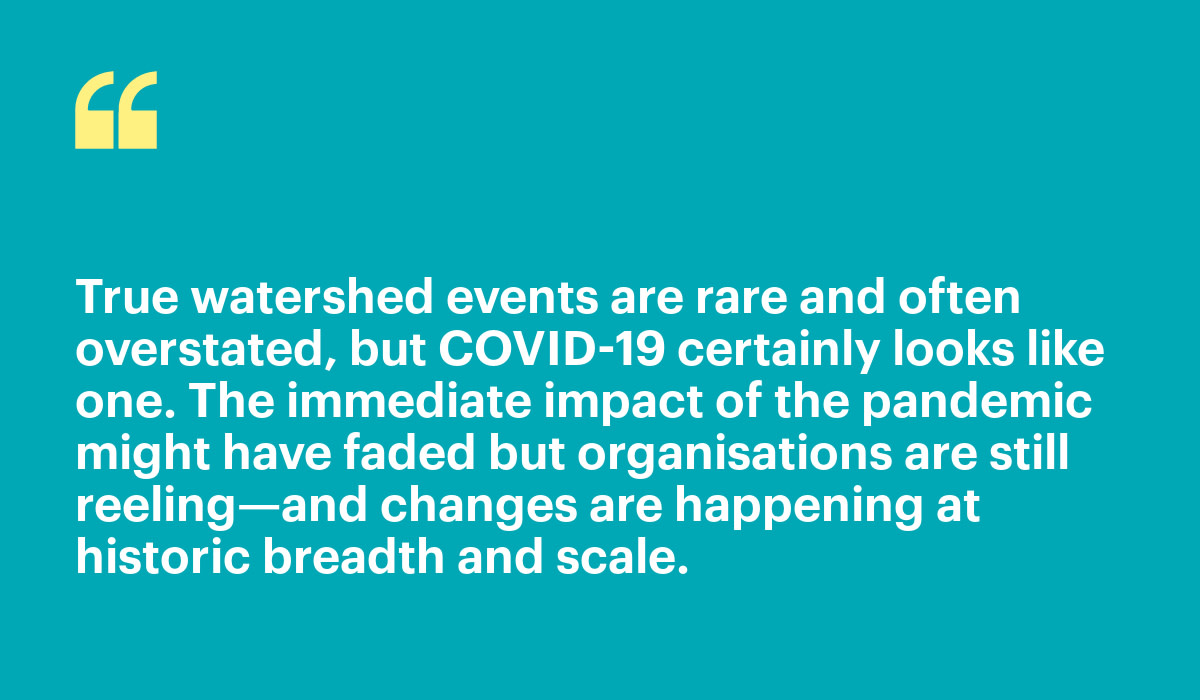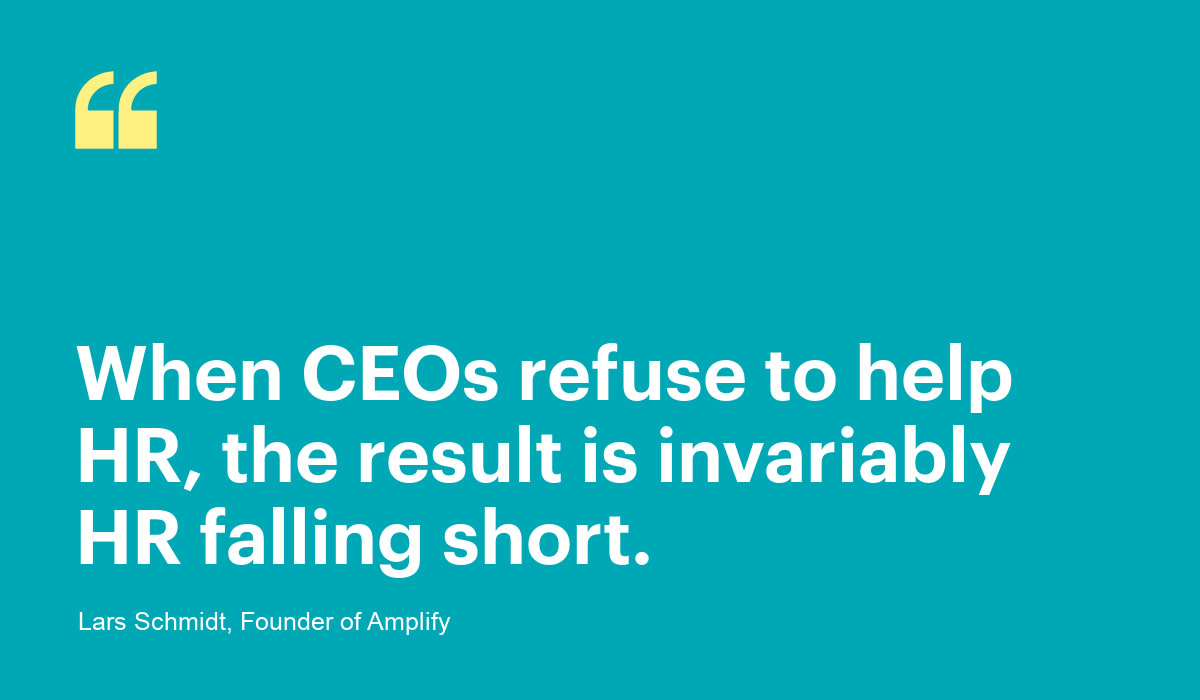Six Questions to Guide CEOs for Post-Pandemic Business Transformation
How do you drive business transformation in a post-pandemic world? Here are six questions to guide CEOs for success.

“Just as the terms ‘prewar’ and ‘postwar’ are commonly used to describe the 20th century,” McKinsey writes, “generations to come will likely discuss the pre-COVID-19 and post-COVID-19 eras.”
True watershed events are rare and often overstated, but COVID-19 certainly looks like one. The immediate impact of the pandemic might have faded but organisations are still reeling—and changes are happening at historic breadth and scale.

Businesses are often having to pivot in multiple directions at once, re-evaluating the value they deliver, how, and to who. Global supply and demand shocks expose major—perhaps catastrophic—vulnerabilities.
And against that backdrop, workforces are in a more tumultuous place than ever.
The aging workforce and changing skills needs have been exerting pressure for years. Add today’s widespread employee unrest—seen in protests happening across Europe and the Great Resignation; spiraling absence rates and plummeting engagement—and we’re staring down the barrel of a massive problem.

The future of work is people powered. Join Visier, Deloitte, and enterprise leaders as they discuss successful strategies for distributing people data to people managers for improved decision making at every level.
When uncertainty is the only certainty, agility is your most important business capability. Being able to handle change quickly will breed resilience. This ability to make adjustments as the business needs change is the bedrock of successful business transformation.
But agility hinges on the workforce. It depends on having the right people in the right places, with the right skills, to deliver. More than that, it depends on those people being engaged, motivated, and empowered to deliver.
These were once issues solely for HR, but the pandemic has forced them onto the boardroom agenda. Leaders know the business landscape might look totally different two years from now compared to two years ago. The winners will be those that best understand and optimise their workforce, to guide transformation and empower agility.
Here are six questions CEOs should ask, to challenge how well your organisation is equipped for post-pandemic business transformation.
1. Do we have the right skills mix to deliver new products or services?
If not, why not? Where are the gaps? And should you plug them by reallocating, retraining, or recruiting?
Agile workforce planning is a critical capability for transformation. Your HR leaders should have the answers to these questions—and accessible insights to optimise each of these tactics, from improving L&D effectiveness to developing smarter acquisition strategies.
2. Are our people resilient enough to adapt to new ways of working?
Employee resilience is a crucial capability for the post-pandemic era. Resilient employees cope better with change; accept new ways of working; are more forgiving of trial and error; are less susceptible to stress.
Cement resilience by giving your people leaders continuous, contextual insight into the employee experience, so they can drive change fast where it’s needed.
3. Will health insecurity hurt our ability to deliver for customers?
The pandemic made massive numbers of people ill, and some are still feeling its effects. Some 46% of UK organisations have had employees suffering from long COVID over the last year, for example. Common symptoms are fatigue, shortness of breath, and cognitive dysfunction that impacts everyday activities.
Managing the cost and business impact of this sickness or absence is crucial. Successful transformation means equipping your people leaders to spot problems and provide help at individual level, while getting you predictive long-term insights to guide your strategic decision-making.
4. Does our leadership team have the right skills to steward business transformation?
The right leadership is instrumental to successful transformation—but leadership development is a challenge compounded by unpredictability.
Gartner predicts more than 40% of leadership roles will be significantly different within five years, for instance, making it difficult to identify and build the right skills. Recent Harvard Business Review analysis suggests organisations typically haven’t kept pace with change, causing a “skills gap in many companies’ leadership pipelines”.
Identifying and closing these skills gaps will ensure you’ve got the team around you and are continually developing your own skills, to make transformation a success.
5. Does our culture support our strategy?
The pandemic triggered major cultural change for almost every organisation—and simultaneously brought issues to the fore, such as digital acceleration. The right culture is integral to your ability to fulfil strategy and successfully deliver transformation, whether digital transformation or business transformation.
The last two years have seen issues around diversity and inclusion (D&I) come to the fore, for example. There’s already plenty of robust evidence that diverse companies outperform peers—that’s become even truer, as D&I becomes a major priority for current and future employees alike. The stakes have never been higher—there’s no option but to get D&I right, right now.
Building a foundation for the organization to thrive means building a culture where every employee thrives.
6. Are our HR leaders empowered to carry the burden of change?
HR have been under extraordinary pressure for the last few years—and HR leaders aren’t just addressing these challenges in the workforce. They’re also subject to them in their own teams.
HR burnout is rife. HR intent-to-leave has skyrocketed—one survey asked HR executives if they had an interest in leaving their current organisation and only 22% said no.
Founder of Amplify Lars Schmidt writes, “CEOs tend to expect a tremendous amount from HR. But when it comes to making these ambitions a reality they’d rather not get involved, leaving HR with a massive task. When CEOs refuse to help HR, the result is invariably HR falling short.”

Business leaders set strategic direction but HR leaders must empower the workforce to deliver this change. Without HR acting as a springboard, business transformation will fall flat. Now’s the time to evaluate whether you’re providing your people leaders with the right support to be agents of the business transformation you need.



